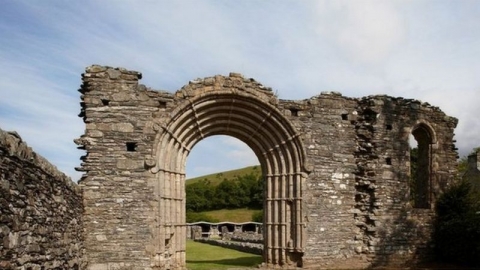Uncovering the mysteries of the Welsh Abbey of Strata Florida

Work continues in exploring the history of Strata Florida Abbey (Welsh: Abaty Ystrad Fflur) and surrounding lands. The ruins of the former Cistercian abbey are situated just outside Pontrhydfendigaid, near Tregaron in the county of Ceredigion, Wales. The abbey was founded in 1164 and the name Strata Florida is a Latinisation of the Welsh Ystrad Fflur; 'Valley of Flowers'. The conserved ruins of the old Abbey church and part of the cloisters are in the care of Cadw (a Welsh verbal noun meaning "keeping/preserving"), which is the Welsh Government's heritage agency.
Immediately south of the abbey are the buildings of Mynachlog Fawr (Old Abbey Farm). which was built between 1670-80. Strata Florida Trust acquired these buildings in 2016 and conservation has recently begun. The aim is to develop the buildings and its surroundings as a Centre celebrating Welsh history, culture and environment in one of its ancient heartlands. The abbey is just one part of the history of this area. Its significance goes back to prehistory, when this was a sacred site long before the abbey arrived.
In furthering this aim the Trust has received £92,400 from the National Lottery Heritage Fund, £80,000 from the World Monuments Fund and £6,000 from the Sacred Landscapes of Medieval Monasteries Project. A number of objects will form part of an exhibition at the centre. Including some mysteriously placed items uncovered recently. These include a ceramic egg and three shoes built into a wall. It is thought they were placed there to ward off evil spirits.
Strata Florida Abbey itself was founded through the patronage of Rhys ap Gruffydd.(c. 1132 – 28 April 1197). He was the ruler of the kingdom of Deheubarth in south Wales from 1155 to 1197. A number of his descendants have been buried at this abbey, including 11 princes of the Welsh royal house of Dinefwr of Deheubarth during the 12th and 13th centuries. The poet Dafydd ap Gwilym (c. 1315/1320 – c. 1350/1370) who is regarded as one of the leading Welsh poets and amongst the great poets of Europe in the Middle Ages is also buried at the abbey.
Strata Florida Abbey was an important and powerful religious centre and was involved in a number of the conflicts of the time. In 1401, during the early years of Owain Glyndŵr's rebellion, Strata Florida Abbey was taken by King Henry IV and his son. The monks were deemed to be sympathetic to Owain Glyndŵr (c. 1359 – c. 1415), the last native Welshman to hold the title Prince of Wales (Welsh: Tywysog Cymru). He was leader of the war of independence with the aim of ending English rule in Wales. As a result of the monks support for him they were evicted from the monastery.
After plundering the abbey the English King Henry IV turned the religious buildings into a military base in his continued fight against the fighters for Welsh freedom. It continued to be used as a military base for further campaigns against the Welsh in 1407 and 1415.
The monastic site was returned to the Cistercians with the end of the Glyndŵr war. Beginning in 1539, Henry VIII used disagreement with the Catholic Church in Rome to dissolve and sack the monasteries of England and Wales. Resulting in Strata Florida Abbey being dissolved in 1539. After which it was left to deteriorate. The site was designated as a Scheduled Ancient Monument in 1919 and is now in the care of Cadw.
Image: Abaty Ystrad courtesy of Cadw





